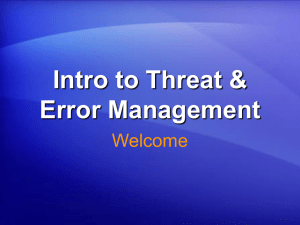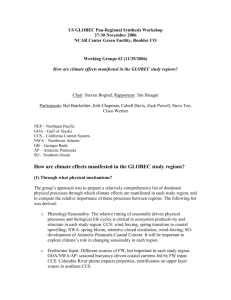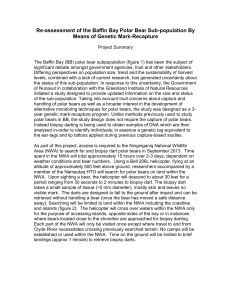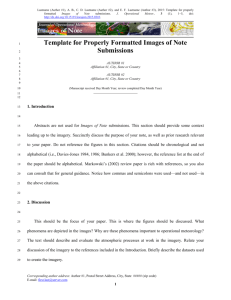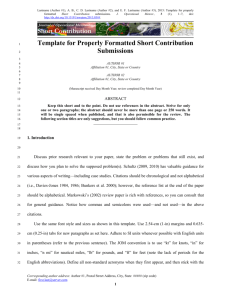October/November Newsletter. - NWA's Member Portal
advertisement
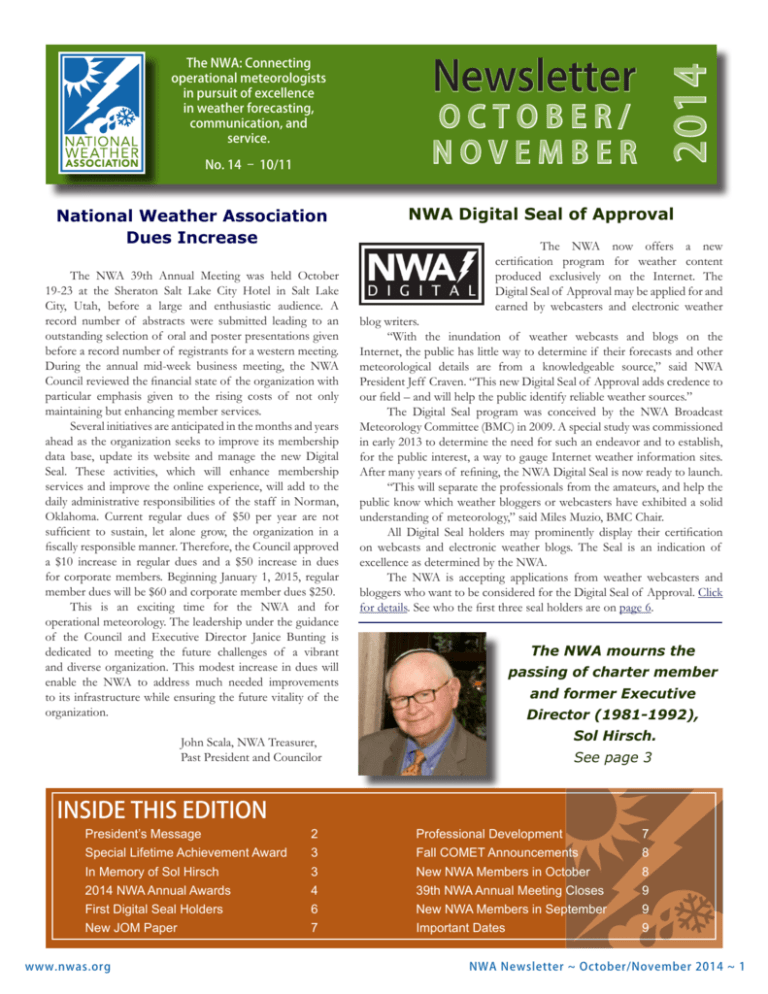
No. 14 – 10/11 National Weather Association Dues Increase The NWA 39th Annual Meeting was held October 19-23 at the Sheraton Salt Lake City Hotel in Salt Lake City, Utah, before a large and enthusiastic audience. A record number of abstracts were submitted leading to an outstanding selection of oral and poster presentations given before a record number of registrants for a western meeting. During the annual mid-week business meeting, the NWA Council reviewed the financial state of the organization with particular emphasis given to the rising costs of not only maintaining but enhancing member services. Several initiatives are anticipated in the months and years ahead as the organization seeks to improve its membership data base, update its website and manage the new Digital Seal. These activities, which will enhance membership services and improve the online experience, will add to the daily administrative responsibilities of the staff in Norman, Oklahoma. Current regular dues of $50 per year are not sufficient to sustain, let alone grow, the organization in a fiscally responsible manner. Therefore, the Council approved a $10 increase in regular dues and a $50 increase in dues for corporate members. Beginning January 1, 2015, regular member dues will be $60 and corporate member dues $250. This is an exciting time for the NWA and for operational meteorology. The leadership under the guidance of the Council and Executive Director Janice Bunting is dedicated to meeting the future challenges of a vibrant and diverse organization. This modest increase in dues will enable the NWA to address much needed improvements to its infrastructure while ensuring the future vitality of the organization. John Scala, NWA Treasurer, Past President and Councilor Newsletter 2014 The NWA: Connecting operational meteorologists in pursuit of excellence in weather forecasting, communication, and service. OCTOBER/ NOVEMBER NWA Digital Seal of Approval The NWA now offers a new certification program for weather content produced exclusively on the Internet. The Digital Seal of Approval may be applied for and earned by webcasters and electronic weather blog writers. “With the inundation of weather webcasts and blogs on the Internet, the public has little way to determine if their forecasts and other meteorological details are from a knowledgeable source,” said NWA President Jeff Craven. “This new Digital Seal of Approval adds credence to our field – and will help the public identify reliable weather sources.” The Digital Seal program was conceived by the NWA Broadcast Meteorology Committee (BMC) in 2009. A special study was commissioned in early 2013 to determine the need for such an endeavor and to establish, for the public interest, a way to gauge Internet weather information sites. After many years of refining, the NWA Digital Seal is now ready to launch. “This will separate the professionals from the amateurs, and help the public know which weather bloggers or webcasters have exhibited a solid understanding of meteorology,” said Miles Muzio, BMC Chair. All Digital Seal holders may prominently display their certification on webcasts and electronic weather blogs. The Seal is an indication of excellence as determined by the NWA. The NWA is accepting applications from weather webcasters and bloggers who want to be considered for the Digital Seal of Approval. Click for details. See who the first three seal holders are on page 6. The NWA mourns the passing of charter member and former Executive Director (1981-1992), Sol Hirsch. See page 3 INSIDE THIS EDITION President’s Message Special Lifetime Achievement Award In Memory of Sol Hirsch 2014 NWA Annual Awards First Digital Seal Holders New JOM Paper www.nwas.org 2 3 3 4 6 7 Professional Development Fall COMET Announcements New NWA Members in October 39th NWA Annual Meeting Closes New NWA Members in September Important Dates 7 8 8 9 9 9 NWA Newsletter ~ October/November 2014 ~ 1 It is not About the Total Snow Amount, it is the Rate Jeff Craven, NWA President After the bone-chilling winter of 2013-2014, which set all kinds of records in the northern Plains and upper Midwest, I was certainly looking forward to summer. After seemingly blinking my eyes, summer has come and gone. The Holidays are rapidly approaching and so is winter. It is hard to find words that describe my level of dread and disappointment. I love forecasting and experiencing winter weather, but could live without the prolonged cold that goes with it. But, since I have little control over the earth’s orbit around the sun and the 23.5 degree tilt of the axis (and since I live in the frozen tundra of Wisconsin), it is time to serve the needs of our customers for snow and ice events. Several years ago I was discussing the issue of forecasting snow amounts in the Great Lakes area. During the conversation, I was focused on snow-to-liquid ratios, but fellow Science and Operations Officer Greg Mann from the Detroit, Michigan, NWS office objected. “It is all about the rates, Jeff. That is what causes most of the important impacts.” Greg was right. Timing and hourly rates are what seem to matter most, along with the road temperature. Snow ratio may be important for influencing the total depth of snow, but ultimately moderate to heavy snow with reduced visibilities and rapid accumulation rates plays a bigger role in impacts to drivers and road crews. Six inches of snow between 10 p.m. and 4 a.m. Friday night into Saturday morning may end up being a minor issue. Two inches of snow between 3 and 5 p.m. on a weekday with temperatures in the lower 20s can have a huge impact on evening rush hour. With our historic emphasis on thresholds, an NWS forecaster in Wisconsin might issue a Winter Storm Warning on the first example above, yet may skip any headlines for the second example. However, most would agree that the potential for adverse impacts is much higher for a couple of inches of snow at rush hour with frozen pavement than for six inches of snow late at night over a weekend. This is the essence of making a journey from thresholds to impacts. Those of you who enjoyed attending the NWA 39th Annual Meeting in Salt Lake City got to see some great presentations on impact -based decision support services. Patricia Boyle of the UKMET Office gave a keynote presentation about their journey towards impactbased products and harnessing a threat matrix. As you can see in the image, the matrix compares the confidence of the event occurring versus the impact of the threat. If you have high confidence of a high impact, then you will be in the red at upper right. Notice that a low likelihood of a high impact is orange, and a good example (Courtesy UKMET Office) of that would be an 2 ~ October/November 2014 ~NWA Newsletter isolated tornadic thunderstorm. So why the big deal? Why not continue to issue products based on thresholds? If we forecast four inches of snow and put out a snow advisory, why doesn’t that satisfy the needs of the customer? Here is just one example of something that did not appear to be a big deal ended up having major impacts. Milwaukee General Mitchell Airport had 3.4” of snow fall on December 8, 2013. Not really a big deal as it was the third snowfall of the season; however, it was rather cold. The previous day’s high temperature was 17 F, and the morning low was 11 F. When the snow arrived in mid morning, temperatures had risen to the middle 20s and winds were about 10 knots. Most road treatments like salt are less effective at melting snow and ice when temperatures are in the middle 20s or colder. A lake-enhanced band of snow moved through southeast Wisconsin, with a quick inch of snow falling in about a 30 minute period. A radar reflectivity snapshot at 10:32 a.m. CST is below for reference, along with some observations from Milwaukee International airport. (1632 UTC KMKX radar 12/08/2013) Abbreviated METARs from Milwaukee 8:52 to 11:14 a.m. 12/8/2014 KMKE 081452Z 9SM -SN M06/M09 P0000 KMKE 081525Z 2 1/2SM -SN M05/M08 P0000 KMKE 081537Z 1 1/4SM -SN M05/M08 P0001 KMKE 081552Z 1SM -SN BR M05/M07 P0001 KMKE 081601Z 3/4SM -SN BR M05/M07 P0000 KMKE 081615Z 1/4SM SN FZFG M05/M07 P0001 KMKE 081642Z 1/2SM SN FZFG M04/M06 P0005 KMKE 081652Z 1/2SM -SN BR M04/M06 SNINCR 1/1 P0005 KMKE 081714Z 1SM -SN BR M04/M06 P0001 (Courtesy WIDOT traffic camera) See PRESIDENT, p. 3 www.nwas.org 2013 Awards Presented at the 2014 Awards Luncheon Special Lifetime Achievement Award Charles A. Doswell III – Doswell Scientific Consulting For his exceptional service and contributions to the operational forecasting and research communities through high–quality scientific research, educational workshops, and mentorship of colleagues and students. (See pages 4-5 for 2014 Awards) PRESIDENT from p. 2 The impacts of this seemingly run-of-the-mill snow event are well documented below with images from the Wisconsin Department of Transportation web cameras and a three-minute video clip from a local Milwaukee network TV news station (WISN-12 TV). I recall that the national media picked up this event as well. It pales in comparison to the Atlanta SnowJam, which occurred about six weeks later and was discussed at length at the Annual Meeting in Salt Lake City. However, I felt that drivers in Wisconsin should have been more experienced and prepared for winter driving conditions. So it was surprising to see them driving so fast in these conditions, especially when they approached the growing pile of crashed cars. https://www.youtube.com/watch?v=PgEfzczce-g (Video courtesy of WISN-12 TV) Forecasting impacts requires a new line of thinking for operational forecasters. As numerical models and access to multi-model ensembles improves, calibrated probabilistic forecasts of hourly snowfall rates can be provided. Combined with road temperatures and typical rush hour traffic times, it is not a stretch to provide reliable estimates of adverse impacts to traffic flow. The vision of a Weather Ready Nation is tied more to timing and intensity of snow than to the total depth of the storm. In the eight years that I have worked at the Milwaukee/Sullivan, Wisconsin, Office, I have certainly found that to be true. www.nwas.org In Memoriam: Sol Hirsch Former Executive Director Sol Hirsch began his weather career in the U.S. Army Air Corps in 1943 when he was selected to attend school for observers at Chanute Air Force Base. He served as an observer at a number of air bases until 1946 when he chose to leave the service and return to college under the GI bill. He returned to the City College of New York in 1946 and received a B.S. degree with a major in Meteorology in 1950. Mr. Hirsch began work for the U.S. Weather Bureau in that same year by accepting an appointment as a weather observer in Baltimore, Maryland. He instituted service at the new Friendship Airport and was soon promoted to the Observer–Briefer category and continued in that capacity until 1952 when he was promoted to the forecaster grade. As a forecaster he prepared forecasts for Baltimore City, Maryland, the Delaware zone forecasts, and for a period the two state forecasts. A number of radio broadcasts originated from the Weather office each day through a local radio station, and Mr. Hirsch delivered several thousand during the period from 1952 to 1962. In 1962 he accepted a promotion to work in the newly formed Weather Bureau satellite program. This program grew in leaps and bounds and soon became an independent agency, and after a series of name changes became known as the National Environmental Satellite Service. The program was based in Suitland, Maryland and involved a daily round-trip commute in excess of 100 miles. In 1966 he enrolled in an evening master’s program at Johns Hopkins University receiving a degree in management science in 1971. In 1978 there was a temporary assignment to the Joint Agricultural Weather Facility in Washington as a satellite specialist in a program sponsored by NOAA and USDA. In 1980 Mr. Hirsch retired after more than 30 years of service. Upon retiring, Mr. Hirsch, in concert with three other retired meteorologists, organized a private consulting firm called Intercon Weather Consultants, which was located in the Suitland area. In 1981, Mr. Hirsch was asked to assume the job of Executive Director for the National Weather Association. In 1988, the members of the consulting company decided to retire again and consequently Mr. Hirsch formed a new company called Capitol Weather Consultants. Sol Hirsch continued as Executive Director in the Temple Hills’ office until the beginning of 1993 when he retired. He remained active as Chairman of the Education Committee for many years. Mr. Hirsch was a charter member of the National Weather Association, and a member of the American Meteorological Association. He was an organizer and charter member of both the Association of American Weather Observers and the International Weather Watchers, two amateur weather organizations that unfortunately are no longer in existence. He was active on the boards of three volunteer organizations and had served as president of one. Sol passed away on Oct. 8, 2014, in Baltimore. He is survived by his wife Shirley, six children, 13 grandchildren and four greatgrandchildren. Contributions in his memory may be sent to Beth Tfiloh Congregation, 3300 Old Court Road, Baltimore, MD 21208 or Sol Hirsch Fund of The National Weather Association, 350 David L. Boren Blvd, Suite 2750, Norman, OK 73072-7125. NWA Newsletter ~ October/November 2014 ~ 3 2014 NWA ANNUAL AWARDS The National Weather Association 2014 Annual Awards were presented by President Jeff Craven at the 2014 Annual Awards Luncheon on October 22 at the Sheraton in Salt Lake City, Utah. The 2014 Annual Award Committee members were: Chairperson Jeffry Evans, Steven Cooper, Joseph Dellicarpini, Chris Higgins, Eric Lenning, Todd Lericos, Jay Martinelli, Mike Paddock, Kris Sanders, Matt Stalley, Dan Valle and Ryan Vaughn. Operational Achievement Individual Award Lans Rothfusz – National Severe Storms Laboratory, Norman, Oklahoma For passion and dedication to the science of meteorology which have led to numerous innovations in the NWS throughout his career, and for maintaining a visionary influence on the future of operational meteorology. Walter J. Bennett Public Service Award Sara Stone (pictured) – CenterPoint Energy and Jackie Miller – City of Houston For providing a shining example of collaboration between private industry and government agencies by organizing and running the annual Houston/ Galveston Hurricane Workshop. Member of the Year Award Bruce Thomas – Chief Meteorologist, Midland Radio Corporation, Kansas City, MO For his dedication over the past eight years, serving in many important roles on the NWA Council. As the NWA President from October 2012 to December 2013, turning his vision into reality by working with the Council to establish a permanent home for the NWA in Norman, Oklahoma 4 ~ October/November 2014 ~NWA Newsletter Public Education Award Dr. Michael Brown – Mississippi State University For his commitment and dedication to increasing weather awareness to the faculty, staff, and students of Mississippi State University and the residents of the State of Mississippi. Local Chapter Award Middle Tennessee NWA Chapter For having a huge impact around the area with community outreach and educational initiatives, including the annual Severe Weather Awareness Day. Trevor Boucher (pictured above) accepted the award T. Theodore Fujita Research Achievement Award Matt Bunkers – National Weather Service, Rapid City, South Dakota For enhancing operational meteorology through his influential research on supercell motion, developing a comprehensive precipitable water climatology, and related techniques and training. www.nwas.org Aviation Meteorology Award Mike Eckert – NWS, Aviation Weather Center/FAA Command Center and Brandon Smith – NWS, Aviation Weather Center/ FAA Command Center For the Exceptional decision support services provided to the FAA Air Traffic Control System Command Center ensuring a safe and efficient National Airspace System. Operational Achievement Group Award Mike Eckert (left) and Brandon Smith National Weather Service Forecast Office Springfield, Missouri For exemplary service during a series of catastrophic flash floods across the Missouri Ozarks during the first two weeks of August 2013. Below front row (l to r): Patti Wentling, Dave Wilham, Megan Terry. Back Row: Drew Albert, Quay Kendrick, Andy Boxell, Gene Hatch. Broadcaster of the Year Award Mike Bettes – The Weather Channel For dedication to educating viewers on the science and danger of tornadoes, and his honesty in admitting mistakes made and lessons learned on May 31, 2013. The Larry R. Johnson Special Award The Southern Region SWAN Team For outstanding leadership and contribution to operational marine forecasting in deploying a high resolution marine model across all the NWS Southern Region Coastal offices. Doug Gaer Ft. Worth, Texas www.nwas.org Tony Freeman Tallahassee, Florida Alex Gibbs Miami, Florida Pablo Santos Miami, Florida NWA Newsletter ~ October/November 2014 ~ 5 The First Digital Seal Holders This year the NWA has added a new certification that recognizes distinction among cyber-weathercasters (those whose work is seen only on the Internet). See page 1 for details. So far, three NWA members are now Digital Seal holders. We will highlight recent Seal of Approval members in the December Newsletter. Bill Murray Bill Murray is Digital Seal #1. He produces the Alabama Weather blog. Bill says he was factory designed to be a meteorologist. Born with an avid interest in all things meteorological, ironically, he spent the first twelve years of his life scared to death of the weather. That all changed on the night of April 3, 1974, when a total of 148 tornadoes tore across the American landscape. Alabama was one of the hardest hit states in that outbreak, with over 80 people killed. “The night seemed like the end of the world to me,” said Murray. “The next morning, I set out collecting clippings of the event, and have been totally hooked on weather ever since. After graduating from high school in 1980, Bill decided against a weather career and moved up the ladder with a Birmingham based hotel management company, going from Front Desk Clerk, to President of the company within 13 years. But weather was still a big part of his life. In 1991, Murray was selected to be the weekend meteorologist at WBMGTV42. He was able to do this until 1996, when he had to quit because of the demands of his hotel job. In 1998, Murray became involved with a new venture, called The Weather Company, along with James Spann and four others. He has been producing weather forecasts for The Weather Company since 2001. The Weather Company changed its name to The Weather Factory in 2012. He is a weekly contributor on the Weather Brains podcast. Bill was named as the NWA Digital Seal Manager in October of this year. Michael Mogil Digital Seal #2 is Michael Mogil, who is a certified consulting meteorologist with B.S. and M.S. degrees in meteorology from Florida State University. Mike has earned the AMS’s Certified Consulting Meteorologist and Certified Broadcast Meteorologist ratings. He now adds the NWA Digital Seal to his repertoire. He has practiced meteorology for more than 40 years, working closely with educators across the country since 1979. Mike also provides expert weather services to attorneys and insurance companies nationwide, provides programs for teachers and students in weather, writes books about weather and articles about weather and mathematics, writes online features about weather and math and helps operate the Mathworks Tutoring Center. Mike has authored/co-authored several books about weather, weather experiments and a comprehensive teacher’s guide for using the newspaper to study weather in the classroom. He has also developed several weather posters and cloud charts. He has written scores of articles for National science journals, and numerous other magazines and newspapers. Most recently, he spearheaded the development of a series called Weather and Climate of the States for Weatherwise magazine. Mike will serve as an NWA Digital Seal evaluator. Jason Samenow Finally, Digital Seal #3 is Jason Samenow of the Washington Post’s Capital Weather Gang. A native Washingtonian, Jason has been a weather enthusiast since age 10 back in 1987 — the year of the double -whammy snow storms that shut schools down seven straight days in the D.C. area. Before graduating from high school, he interned for NBC4 chief meteorologist Bob Ryan. At the University of Virginia, he earned a degree in environmental science, focusing in atmospheric science. He went on to earn an M.S. in atmospheric science at the University of Wisconsin-Madison in 2000. Jason is currently the Washington Post’s weather editor. From 2000 to September 2010, he worked as a climate change analyst for the federal government, monitoring, analyzing and communicating the science of climate change. He founded CapitalWeather.com in early 2004, the first professional weather blog on the Internet which was absorbed by the Post in 2008. Jason lives with his wife, Deborah, and son, Evan, in Washington, D.C. The NWA happily welcomes these first Digital Seal holders into the company of individuals who have crafted a professional weather presentation through diligence and hard work. Today, they join a select group of men and women who illustrate the benchmark of excellence by their example. Newsletter Submissions We welcome Newsletter article submissions from members. Send articles to nwanewsletter@nwas.org by the 25th of the month for publication in the following month’s edition at the earliest. Information about the Newsletter and a link to author guidelines can be found at www.nwas.org/newsletters/. 6 ~ October/November 2014 ~NWA Newsletter www.nwas.org NEW JOM PAPER: Verification of NWS Spot Forecasts One article has been published the NWA’s Journal of Operational Meteorology (JOM) since the July Newsletter update. There are four categories of papers that can be published in JOM. To see their names and descriptions, go to www.nwas.org/ jom/call_for_papers.php. If you are interested in submitting a paper to JOM, go to www.nwas.org/ jom/index.php for author information. JOM 20 (Article): Verification of National Weather Service Spot Forecasts Using Surface Observations, by M. R. Lammers and J. D. Horel. Thank you to the JOM authors, reviewers and editors for continuing to make JOM a success. You can read the papers by logging on to the NWA Member Portal at member.nwas.org/ and clicking on the JOM link under Additional Member Resources on the right. Figure 15a in JOM 20 showing the mean error in the temperature forecast (C) for prescribed burn forecasts as a function of NWS County Warning Area. 2014-15 NWA sponsored Annual Meetings, Conferences and Special Events (click titles to view websites) March 6-8: 40th Northeastern Storm Conference It will be held in Saratoga Springs, New York, and is sponsored by the Lyndon State Chapter of the AMS & NWA. Abstracts will be accepted online December 1, 2014 through February 6, 2015. Abstract acceptance will be on a spaceavailable basis, and early abstract submission is highly recommended. PROFESSIONAL DEVELOPMENT March 26-28: 19th Annual Severe Storms and Doppler Radar Conference Sponsored by the Central Iowa NWA Chapter, it will be held at the Courtyard by Marriott in Ankeny, Iowa. March 28-29: 13th Annual Southeast Severe Storms Symposium The East Mississippi Chapter of the NWA/AMS conducts this symposium. Watch their website for an announcement about keynote speakers. October 17-22: 40th NWA Annual Meeting The Renaissance Oklahoma City Convention Center Hotel is the host site for the meeting. Meetings will be held next door in the Cox Convention Center. It is our 40th anniversary, so plan to attend this informative meeting and celebration. Other Meetings, Conferences and Special Events in 2015 January 4-8: 95th AMS Annual Meeting “Fulfilling the Vision of Weather, Water, and Climate Information for Every Need, Time and Place” is the theme. It will be in Phoenix, Arizona. February 13-15: 17th Annual National Storm Chaser Convention This convention will be held in Denver, Colorado. Speakers include Tim Marshall and Dr. Greg Forbes; there will be a Forecasting Class held in conjunction with the meeting. February 23-25: National Tornado Summit Held in downtown Oklahoma City, the National Tornado Summit improves disaster mitigation, preparedness, response and recovery in order to save lives and property in the United States. Attendees will have the opportunity to attend five general sessions and seven breakout sessions in five different tracks: Adjusters, Emergency Management, Producers, Special Interest and National Severe Weather Workshop. February 27-28: Northwest Weather Workshop Sponsored by NOAA’s NWS, the University of Washington and the Puget Sound Chapter of the AMS, the theme is: “Advances in High-Resolution Prediction over the Pacific Northwest”. www.nwas.org NWA Newsletter ~ October/November 2014 ~ 7 Fall Quarterly Announcement from COMET Wendy Schreiber-Abshire COMET Senior Project Manager/Meteorologist Read on for highlights of our most recent MetEd publications. We’ve been busy hosting courses, translating previously published materials, and starting new initiatives. Our new English language distance learning publications this quarter include new material on the GOES-R Geostationary Lightning Mapper (GLM), atmospheric dynamics, precision and accuracy, and water purification and desalination. Please follow the links of most interest to you for more information about each release. New English Modules: GOES-R GLM: Introduction to the Geostationary Lightning Mapper, 1 hour https://www.meted.ucar.edu/training_module.php?id=1080 This extension of the COMET module “GOES-R: Benefits of Next Generation Environmental Monitoring” focuses on the GLM instrument, the satellite’s lightning mapper. Quasi Geostrophic Vorticity Equation (interactive widget) https://www.meted.ucar.edu/training_module.php?id=1142 This learning object/widget is designed for upper-level undergraduates or forecaster interns who want to apply their knowledge of the quasi-geostrophic vorticity equation to forecast situations. Precision and Accuracy in Geodetic Surveying, 15 minutes https://www.meted.ucar.edu/training_module.php?id=1146 This brief video focuses on the importance of both precision and accuracy in geodetic surveying and the difference between them. Interviews with Frank Leitz, Senior Chemical Engineer, Bureau of Reclamation, 30 minutes https://www.meted.ucar.edu/training_module.php?id=1098 In these three short video interviews, Frank Leitz shares stories and lessons learned from his work on water purification and desalination projects. COMET NEWS New Spanish Modules: Tormentas locales severas tropicales, 1 hour https://www.meted.ucar.edu/training_module_es.php?id=1130 La OMJ, las ondas ecuatoriales y la ciclogénesis tropical, 1 hour https://www.meted.ucar.edu/training_module_es.php?id=1128 Ondas tropicales del este, 1.5-2 hours https://www.meted.ucar.edu/training_module_es.php?id=1120 Interacciones entre masas de aire tropicales y extratropicales en Sudamérica, 1 hour https://www.meted.ucar.edu/training_module_es.php?id=1127 Temas de meteorología dinámica: El viento térmico, 1.5-2 hours https://www.meted.ucar.edu/training_module_es.php?id=1072 New French Modules: Inférer trois dimensions à partir de l’imagerie de vapeur d’eau, 1 hour https://www.meted.ucar.edu/training_module_es.php?id=1135 Applications des données d’ensemble l’hiver , 1.5-2 hours https://www.meted.ucar.edu/training_module_es.php?id=1126 Currently, these materials are freely available to everyone, courtesy of our primary sponsors. They are NOAA’s NWS, NESDIS and National Ocean Service programs, EUMETSAT, the Naval Meteorology and Oceanography Command, the Meteorological Service of Canada, Bureau of Meteorology, the U.S. Army Corps of Engineers, and the Department of the Interior Bureau of Reclamation. 8 ~ October/November 2014 ~NWA Newsletter Welcome to the NWA! Here are new NWA members as of October: Regular/Retired/Military Samuel Agyemang Anthony Bailey John Blood Skip Breeden Steve Brueck Corey Christiansen Dave Cochran Margaret Curtis Rob D’Arienzo Matthew Euler Keisha Fitzgerald Mike Gismondi Freddrick Gossage Douglas Hilderbrand Patrick King Collin Myers James Reynolds Danny Satterfield Mark Seguljic Lance Steele Paul Suffern Edward Szoke Evan Webb Student members Mary Brown James Brownlee Tomer Burg Alexander Calamia Christopher Castellano Rachel Dougherty Lauriana Gaudet Kurt Hansen Darrel Kingfield Andrea Paparelli Lauren Rautenkranz Matthew Schlagel Scott Sincoff Brian Squitieri Kate-Lynn Walsh Jillian Young See page 9 for September’s new members! www.nwas.org 39th NWA ANNUAL MEETING SUCCESSFULLY CLOSES A big thank you to everyone who came to the NWA’s 39th Annual Meeting in Salt Lake City, which ended October 23. We had 574 attendees! If you missed any of the #NWAS14 meeting, you can catch up with our summaries on Storify. A special thank you to all our meeting sponsors, donors and exhibitors. We appreciate all of the members who volunteered their time and effort to make the meeting a great success! Welcome to the NWA! IMPORTANT DATES Regular/Military/ Retired Members Gloria Bunting Bryan Busby Alan Conklin Erik Crosman Brian Hartman Dean Hazen Cameron Hopman Karla Huelga Chris Karstens Alek Krautmann Jason Laird Robert Lehmann Andrew Logsdon Timothy Lynch Marne Meynig Aimee Mottl Cody Oppermann Nicole Peterson Erik Pindrock Bradley Scalio Jason Scalzitti Jeffrey Williams Student Members Adam Abernathy Brian Blaylock Douglas Catharine Michael Chereskin Roland Christensen Lacey Clifton Andrew Courtney Jacob DeFlitch Chris Easlick Bri Eggers Nicholas Elmer Ben Fasoli December 21, 2014 Winter begins at 6:30 pm EST December 31, 2014 Last day to vote in the NWA 2015 election for officers and councilors February 5, 2015 National Weatherperson’s Day www.nwas.org Here are new NWA members as of September (see page 8 for October’s new members): Katie Flynn Kelly Neugent Jesse Guinn Ryan Phillips Aaron Haegele Cody Poché Kimberly Hartmus Karlie Rees Andrew Havercroft Daniel Schaffer Alex Iannone Adam Solarczyk Alexander Jacques Jennifer Tate Dylan Jeffrey Kai Tawa Kellee Judy Alyssa Taylor Alexandra Kabeiseman Matthew Kovall Corporate members Nate Larsen (click for their URL) Luke Leclair-Marzolf Gabriel Lojero Center for Climate Katherine Long Change Communication Brandon Lovato Derek Mallia WeatherBELL Richard McAlister Analytics LLC Cameron Negrete NWA Newsletter (ISSN 0271-1044) Technical Editor: Winnie Crawford Editor and Publisher: Janice Bunting, NWA Executive Director Communications Coordinator: Hulda Johannsdottir, NWA Design/Layout: Mollie Doll (treefrogresources.com) Published monthly by the National Weather Association, 350 David L Boren Blvd Ste 2750, Norman, OK (USA) 730727125; phone ~ (405) 701-5167; exdir@nwas.org; www.nwas.org. Submit newsletter items to nwanewsletter@nwas.org using the Instruction for Authors at http://www.nwas.org/newsletters/ newsletter_instructions.php. Members receive the Newsletter on-line and access to an on-line portal which includes the Journal of Operational Meteorology as part of their regular, student or corporate membership privileges. Address, phone number, email and affiliation changes can now be made online: member.nwas.org. NWA Newsletter ~ October/November 2014 ~ 9
